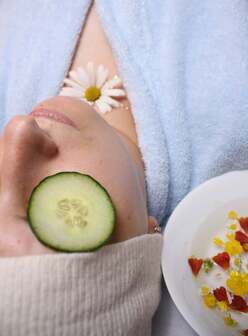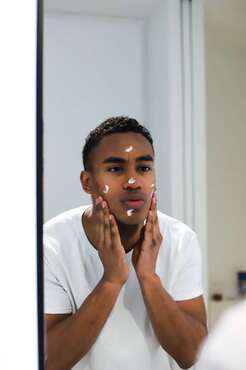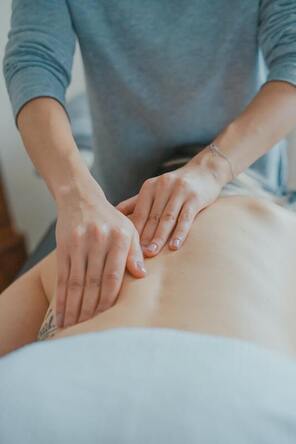 Skin type, texture, and skincare needs are different for everyone. It would be great if there was a one size fits all skincare routine for every single person, unfortunately, it does not work that way. If you asked every person you know about their skincare routine, we could almost guarantee that each person would have a different answer. Some people could have a routine that only involves rinsing their face with water morning and night, and others might swear by their expensive serums, moisturizers, eye creams, sunscreens, and toners. Genetics also play a huge role in what our skin texture and aging can look like. Climate is yet another factor in determining skincare needs. Going to a store like Sephora or even Walgreens can be extremely confusing. Choosing between the thousands of products in the skincare aisle can be overwhelming and trying to understand the ingredients can be a daunting task. Making the choice of what you’re going to apply to your biggest organ (your skin) is an important one. Don’t worry, we are here to help!! There are a few basic rules for skincare that you should know, and everyone can benefit from. We have broken it down into a simple formula that’s easy to understand. 1. CLEANSING: Use a gentle cleanser to remove dirt, oil, and toxins. WHY THIS IS IMPORTANT: Cleansing your face morning and night is a step that you never want to skip because it removes the dirt and oil that builds up over the course of the day and night and any toxins or allergens that you have encountered throughout the day. When choosing a product, be sure to stick to a gentle cleansing formula so you don’t disrupt or strip your skin’s natural protective barrier. A cleanser does not need to be expensive or fancy. It is made to remove things that should not be on the skin and balance the skin out. It doesn’t stay on the skin so expensive, formulated ingredients aren’t going to do much. 2. EXFOLIATING ONCE OR TWICE A WEEK: You want to remove any dead skin build-up. There are different ways to do this. You can use a mechanical exfoliant like a scrub, or a topical exfoliant that will gently remove the dead skin and buildup. WHY THIS IS IMPORTANT: In addition to clearing away dead and dry skin, a regular exfoliation routine can improve your skin’s clarity, radiance, and youthfulness by unclogging pores and boosting circulation and lymphatic drainage. The process of removing dead and dry skin allows your other skincare products to penetrate more deeply and effectively by removing outer layers that may block the products from reaching the areas it needs to. Over time, exfoliation helps stimulate collagen, improving your skin’s texture and lessening the appearance of fine lines and wrinkles. 3. TREATMENT: Designed to nourish, protect, and hydrate your skin, a face serum or mask offers a concentrated dose of active ingredients that should be applied between cleansing and moisturizing. WHY THIS IS IMPORTANT: Think of a serum or mask as your secret weapon to combat skin issues such as discoloration, dullness, fine lines, or acne. There are different types of serums with amazing ingredients that brighten and hydrate while combatting issues such as aging, acne, rosacea, or autoimmune skin disorders. There are a lot of buzzwords in the skincare industry. Try to skip the hype and look out for some key ingredients that can really make a difference. A few to look out for are: Retinol Topical retinoids (including retinol) help your skin speed up its normal cell-turnover process, meaning it will shed skin cells more quickly. That helps tackle issues like fine lines, wrinkles, dark spots, and acne. Researchers also think retinol can help increase collagen production, which further reduces signs of aging. Vitamin C Is an antioxidant to counteract and protect against free radicals. Plus, it can also be used to effectively brighten dark spots over time. Niacinamide Is a form of vitamin B3 that has shown to fight free radical damage, brighten dark spots, and manage acne. Those with sensitive skin will be pleased to know that some research shows it can brighten skin with fewer side effects or irritation than other first-line treatments, like hydroquinone. Salicylic acid Can be used as an acne treatment, this beta-hydroxy-acid (BHA) has some serious exfoliating powers, which makes it a good option for managing signs of aging as well. There’s evidence to suggest it can also boost the production of collagen. Glycolic acid Is one of two major alpha-hydroxy-acids (AHAs). Glycolic acid is a chemical exfoliant that’s regularly used in products like peels and exfoliating toners, pads, cleansers, and creams. It works by dissolving the bonds between skin cells. Lactic Acid Is another, often gentler, AHA. It works similarly to other chemical exfoliants—meaning it removes dirt and dead skin cells—but tends to be easier on sensitive skin. Azelaic acid Is another type of acid that’s useful for exfoliating purposes. In fact, it comes in a few different prescription forms, which are prescribed to treat acne and rosacea (especially the type of rosacea that comes with acne-like bumps). Hyaluronic acid Is one of the most common humectant ingredients out there today and helps maintain hydration in your skin. It’s also a compound that’s found naturally in the skin, which makes it unlikely to cause irritation or allergic reactions. Ceramides Work as a barrier to seal in moisture and protect your skin. 4. PROTECTION: Moisturizer and sunscreen. WHY THIS IS IMPORTANT: Moisturizer is what holds moisture in creating a barrier to protect your skin from the elements. This should be the last step in your daily skincare routine. Choosing one that is appropriate for your needs and time of day is important. For example, if you are going to be in the sun, having a moisturizer with an SPF can be a game-changer for protecting your skin. Choosing one that is appropriate for your skin type and age is just as important. You will most likely be using a more nutrient-dense moisturizer for the evening and one that is going to protect from the sun’s rays for daytime. We believe that less can be more, or quality over quantity is a great rule of thumb. Self-care rituals are important not only for our physical health but also for our mental health. Taking care of your skin falls under self-care and improves self-worth. Where do Professional Facials in Jacksonville, Florida fit into your Skincare Routine? What you do on a daily and weekly basis for your skin is always the most important step to the complexion of your dreams. However, getting a series of professional facials can help you to correct imbalances such as acne, blackheads, dullness, wrinkles or discoloration. Even if you don't have any major skin concerns, a facial on a monthly or quarterly basis can be an important part of your overall skincare plan. Facials help to improve circulation to the skin and face muscles with facial massage, resurface and extract impurities from the skin and help to deeply moisturize in a way that's hard to always do at home. Professional facials can help to fill any gaps in your at-home regimen, and give your skin a supercharge of health and vitality. We would love to help you find your best skincare regimen and we offer complimentary skincare consultations in Jacksonville, Florida. Schedule online now or give us a call. Call Us (904) 512-7551
0 Comments
Do you ever wonder which type of massage is best for you and your specific needs? Are you suffering from chronic pain? Maybe anxiety or insomnia? Or do you have a sports injury? Finding the right massage technique and therapist for you will be crucial for meeting your health and pain relief goals. We are massage therapy experts in Jacksonville, Florida and we are here to guide you to the correct massage service for your specific situation and health goals. Before your massage, make sure to ask your massage therapist about which techniques are right for you. You may also contact us and receive guidance from our clinical team on which massage is right for your specific condition prior to coming in. Learn more about our massage therapists and their specialties here. Here is a brief overview of the numerous types of therapeutic massage therapy we offer at The Wellness Hub, right here in the heart of Jacksonville, FL: Relaxation Massage - Relaxation (also called Swedish Massage) massage is one of the most commonly offered types of massage therapy in the western world. It is called Swedish massage because it was invented at the University of Stockholm in Sweden in the 1700's by a physiologist who also pioneered the practice of physical therapy. A relaxation massage is generally given as a full body massage, which includes the neck, shoulders, back, head, arms, hands, legs and feet. A relaxation massage uses light but firm strokes to induce the release of tension from the muscles and to calm the nervous system. This type of massage stimulates the lymphatic system, which helps to facilitate the removal of toxins from the body...so a relaxation massage is good for whole body health. In a relaxation massage, special focus will be given to areas of concern such as the back, neck or any other area you mention to your therapist. Sometimes relaxation massage will be used to warm up the muscles before moving on to other massage techniques such as deep tissue or neuromuscular massage. Deep Tissue Massage - Deep Tissue is similar to Relaxation massage, however pressure is applied to the deeper layers of the muscle and fascia (connective tissue) to address chronic or acute pain and tension. It can be used to treat strains and sports injuries, as well as repetitive strain injuries (which can come from working at a computer or being on a phone). Sound familiar?? Neuromuscular Massage/Medical Massage - This is also called Clinical Massage or Trigger Point Massage. This type of massage is very specific for treating chronic pain syndrome or specific orthopedic conditions. Examples of the types of conditions neuromuscular massage can treat are: sciatica, carpal tunnel syndrome, rotator cuff injuries, thoracic outlet syndrome, frozen shoulder, knee pain, tension headaches, nerve entrapment, tendonitis, plantar fasciitis and more. Neuromuscular massage is good for athletes as well as someone with an orthopedic injury or a repetitive strain injury. Trigger point therapy is employed often in neuromuscular massage, which is specific pressure applied to areas of taut and tense muscle fibers, which can feel like a knot or even a marble. Trigger points tend to "refer" pain to other areas, which means it can cause pain in areas other than just where the trigger point is. It's important to note that neuromuscular massage isn't as relaxing as a traditional massage (like a Swedish or deep tissue) and usually doesn't address the whole body (just the specific areas of pain). Neuromuscular massage is an excellent option for correcting long standing pain patterns. Since this is a medical massage, a treatment plan will likely be recommended, just as if you were going to a chiropractor or physical therapist. Hot Stone Massage - This type of massage has been used in many ancient healing traditions, first in ancient Indian and Chinese medicine. The modern form of hot stone massage originated in Hawaii and uses warmed, smooth basalt stones to massage the body. The heat penetrates into the muscles to further relax them and improve circulation. It is a comforting, luxurious and deeply relaxing treatment! Cupping Therapy - Cupping therapy has been used in ancient healing systems throughout the world, but most notably in Traditional Chinese Medicine. In the west it used to be that cupping was something you'd only get when you saw an acupuncturist, but now many massage therapists incorporate this modality into their massage (thank goodness!). Cupping uses plastic, silicone or glass cups to apply negative pressure to the muscle and connective tissue. This has many similar benefits of massage such as relaxation to the muscle and improved circulation, but instead of compressing the tissue like in massage - it decompresses it - which allows for effective pain relief. Cupping can be done as stationary cupping (the cups are left in one place) or sliding or massage cupping (when the cups are glided across the body). Cupping therapy is excellent for treating many different types of pain syndromes, especially low back pain, shoulder pain, neck pain and tension headaches. Reflexology - Reflexology, like cupping therapy, is a system of massage that also comes from East Asian Medicine and Chinese medicine. It involves the theory that different zones of the feet and hands can impact other parts of the body, including organs and regions of the body such as the neck, shoulders or back. Indeed, there is evidence that pressure on the hands or feet can stimulate the central nervous system, which has an impact on areas of the body away from the hands and feet. This is similar, but not exactly the same, as acupuncture theory. Reflexology is deeply relaxing and while it can help pain in the feet or hands, it can impact so many other areas of your health. We hope that this has given a good overview of different types of massage therapy available. If you are still wondering what type of massage therapy is best for you or which practitioner would be best for you, please feel free to reach out to our clinical director here or call (904) 834-0740 and we'll be happy to help match you up to the best type of therapy and therapist for you. Remember, there are a couple of things that make our massage services different from other spas and massage establishments:
---- We are pleased to serve the following Florida communities with massage therapy, chiropractic, organic skincare, acupuncture, red light therapy and more: Jacksonville, Orange Park, Fleming Island, Mandarin, Jacksonville Beach, Nocatee, St Johns, Ponte Vedra and more. Call Us (904) 512-755 |
AuthorThe Wellness Hub Center for Massage Therapy, Acupuncture, Organic Skincare and Holistic Health in Jacksonville, Florida. A place for wellness, healing and renewal. Categories
All
Archives
July 2024
|



 RSS Feed
RSS Feed